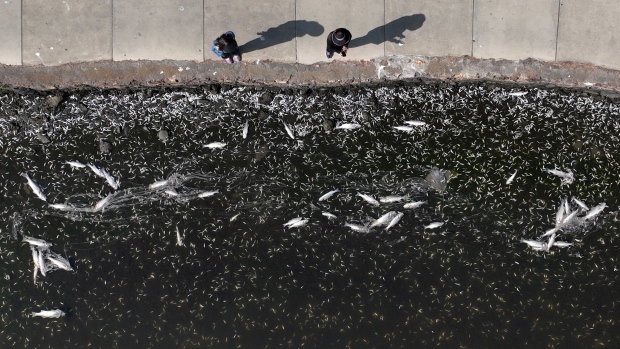Jul 5, 2023
Toxic Algae Outbreaks Off US West Coast Set to Worsen With El Nino
, Bloomberg News

(Bloomberg) -- Sea lions and dolphins have been washing up sick or dead on Southern California beaches, poisoned by eating fish containing a dangerous neurotoxin. It’s the result of a harmful algae bloom, a natural phenomenon that turns water blue, bright green, brown or red, and occurs mostly in the summer and fall.
Algae blooms have been supercharged in recent years by agricultural pollution and global warming (the algae prefer warmer water). The returning climate pattern known as El Niño raises the likelihood of toxic algae outbreaks on the US West Coast and may do the same in Florida, though its influence there is not as clear cut.
Toxic algae can cause nausea, vomiting and skin irritation in humans, and can kill dogs and marine animals exposed to it. Severe blooms can force fishermen to shut down their operations due to risks to food safety. The National Oceanic and Atmospheric Administration (NOAA) estimates that nationwide, such events cause about $82 million in losses for the US seafood, restaurant, and tourism industries.
El Niño is set to cause more weather turmoil, test power grids and disrupt the global supply chain. Experts say its effects on algae outbreaks will vary considerably from place to place and species by species. It “depends on where and which harmful algae blooms,” says Richard Stumpf, an oceanographer at NOAA, which provides toxic algae forecasts across the US. “There are different harmful algae species, and they thrive in different environments.”
On the West Coast, blooms of algae harboring a toxin that can poison humans and animals are more likely to occur under El Niño’s influence, Stumpf says. Domoic acid — produced by Pseudo-nitzschia algae — is believed to have killed hundreds of sea lions off California in June alone.
El Niño is also expected to push blooms of Pseudo-nitzschia further up the Pacific coast, to areas that have rarely experienced the problem let alone prepared for it, according to Raphael Kudela, a phytoplankton ecologist at the University of California at Santa Cruz. In 2015, a monstrous bloom of toxic algae stretched all the way from central California to Alaska, fueled by El Niño and other factors.
So-called red tides will likely become more common along the West Coast this year, too, since Lingulodinium polyedra, another toxic algae species, flourishes in warmer and wetter weather, Kudela says.
Read More: Algae Blooms Visible From Space Increased as Climate Warmed
For Florida, El Niño is more of a wild card. Higher temperatures, intensified rainfall and suppressed hurricane activity associated with the pattern all play roles in the growth of algae, making it challenging to assess the overall impact, says Edward Phlips, a University of Florida professor who researches harmful algal blooms. And the same factor could even produce opposite effects.
Take heavier rainfall: It theoretically introduces more agricultural runoff to waterways, essentially fertilizing the algae. But on some occasions, intense rains have also been found to help reduce the potential for algal blooms, since increased water flows shorten the amount of time that nutrients remain in a lake or estuary.
“El Niño causes more precipitation in the winter and early spring in the southernmost US. This may influence blooms in estuaries next year,” says Stumpf of NOAA. “But we don’t have a good understanding of that relationship.”
That adds to the challenge of fending off toxic algae in Florida, which has 825 miles of coastline and thousands of lakes. In 2018, an outbreak of virulent cyanobacteria (commonly known as blue-green algae) in Lake Okeechobee was so severe that Florida declared a state of emergency in seven counties. For weeks, the foul-smelling algae clogged waterways, prevented fishing and turned away visitors.
Projections for the Great Lakes region are more positive. Lake Erie will likely experience milder-than-average blooms. A dry spring is expected to spare the fishing hub from a massive outbreak, according to a forecast released by NOAA last week. That’s good news for locals whose beloved lake in recent years has been overrun by cyanobacteria.
Around the country, scientists have stepped up their efforts to predict and monitor when and where harmful algae blooms, providing insights for businesses and communities hoping to lessen the damage.
Even so, “it’s difficult to predict accurately beyond several days,” Kudela says of the current modeling for California. “Similar to weather forecasts, the uncertainty increases rapidly as you go further into the future.”
©2023 Bloomberg L.P.


